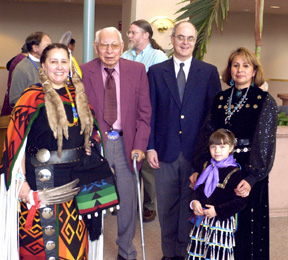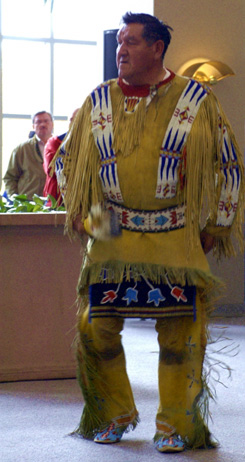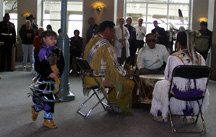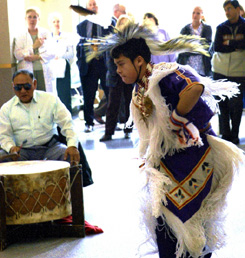 |
Left to right: Ella Alexander, Elmer Blackbird, James Armitage, M.D., Terri Kalinowski and granddaughter Jordan Williamson. Photo by Hamilton Pettigrew. |
Native Americans brought their cultures and heritages alive Nov. 14 during a multicultural program in the Durham Outpatient Center West Atrium. The program was sponsored by the NHS/UNMC Employee Diversity Network as part of the organization’s on-going mission to pursue more cultural enrichment opportunities on the NHS/UNMC campus.
The master of ceremonies was Elmer Blackbird, a senior member of the Omaha tribe, who led the audience through a montage of historical anecdotes and background on everything from the origins of the “pow wow” and the contributions of Native American military veterans, to detailed descriptions of tribal dance routines, clothing and artifacts.
Great nephew of Dr. Picotte
Blackbird is the great nephew of Susan LaFlesche Picotte, an Omaha Indian who became the first Native American female physician in the United States. Dr. Picotte was the youngest daughter of Joseph LaFlesche, also known as Iron Eye, the last recognized chief of the Omaha tribe. She graduated from the Women’s Medical College in Pennsylvania in 1889. She finished the three-year course in just two years and was first in her class of 36 students.
 |
Rufus White dances during the ceremony. Photo by Hamilton Pettigrew. |
Although Dr. Picotte practiced medicine among the Omaha tribe, she served patients of all races. She was co-founder of the Thurston County Medical Association and, in 1913, also founded a 12-bed hospital in Walthill, Neb. She died in 1915, after practicing medicine for 26 years, and the hospital was renamed the Susan LaFlesche Picotte Memorial Hospital. In 1993, the hospital was designated a National Historic Landmark by the National Park Service.
In 2001, Dr. Picotte was posthumously inducted into the International Women in Medicine Hall of Fame of the American Medical Women’s Association in McLean, Va. Blackbird attended the ceremony and accepted her award. On Sept. 14, 2002, he visited Walthill for Dr. Susan LaFlesche Picotte Day and presented the award for permanent display at the historic hospital.
Code talkers, pow wows
During the EDN program, Blackbird addressed the audience from a podium covered with a commemorative blanket dedicated to the World War II Navajo Indian code talkers. Designed by Navajo historians and commissioned by the Pendleton Mills Company, the blankets honor the specially trained Navajo radiomen who used their native language to convey military information during the war against Japan in the Pacific. The Navajo code is the only code the Japanese never broke.
Blackbird explained that he had no idea where the phrase “pow wow” came from, but said that following the war the Omaha tribe was the first tribe to create the organized tribal dance gatherings that today are commonly referred to as “pow wows.”
 |
Jordan Williamson does a solo jingle dance. Photo by Walter Brooks. |
“Today, there are only a few elders left on our reservation who speak the Omaha tribal language fluently and practice all the old traditions. In fact, my wife, Nancy, and I are teaching the Omaha language to public school students. When I visit the reservation now I see people doing things I don’t remember and at my age, I no longer have anybody older than me to ask questions about our traditions.”
Song and dance
The program began with Rufus White and Eugene Pappan drumming and singing an ode to military veterans. U.S. Marine Corps Sgt. John Dupnik served as color guard and brought the American flag into the dance floor. He was followed by Ella Alexander, Terri Nockai Kalinowski and her granddaughter, Jordan Williamson and Brian Sweet, who circled the drummers and performed a solemn dance fallen soldiers.
“Unlike singing the Star Spangled Banner, when Native Americans sing our song of patriotism and remember our veterans, we sing and dance with reverence,” Blackbird said. “We do not sing this song as a prelude to a ball game or entertainment event and we don’t cheer when it ends. Usually the only sounds are women crying as they remember their loved ones lost in war.”
Native dress
Kalinowski wore a Navajo dress, while Alexander wore a traditional dress style from her Omaha tribe. Sweet’s clothing style and performance is called the “grass dancer,” while 6-year old Williamson wore a jingle dress, which is covered with small bells. White’s tribal clothing was an outfit made by his great grandfather in 1860 and handed down as his family’s most precious heirloom. There are only four such original tribal outfits remaining among the Omaha people.
 |
Dancer Brian Sweet with Eugene Pappan on drum. Photo by Hamilton Pettigrew. |
The most important aspect of Native American dancing is that every dance has a specific purpose. The jingle dress, for example, is worn for the jingle dance – a religious ceremony for people with health problems. Other dances are competitive exhibitions of physical prowess and creativity, while others may be for mourning, celebrating childbirth or part of courtship.
In addition to the dancing, there were display tables filled with Native American artifacts, clothing, jewelry, crafts, paintings, musical instruments and a wide array of books and multimedia teaching accessories on Native American cultures and histories.
Dr. Armitage: No genetic difference
“America is made up of people from all over the world, but our country started with the Native American core of brave and strong peoples,” said UNMC College of Medicine Dean James Armitage, M.D., in closing remarks. “Diversity is important and it is appropriate that we try to incorporate and recognize the traditions of many different cultures.
“But events like this are also an opportunity to remember that while many look different and share different traditions, we really are more alike than not alike. Genetic research has proven conclusively that there is no fundamental genetic difference in human beings, and that there is no way to genetically define race. All human beings have the same genetic make up.
“While we celebrate diversity, let us also remember that we all want the same thing — to raise our children in a safe environment, have meaningful creative work and be able to contribute to our communities and our country as fully respected citizens.”